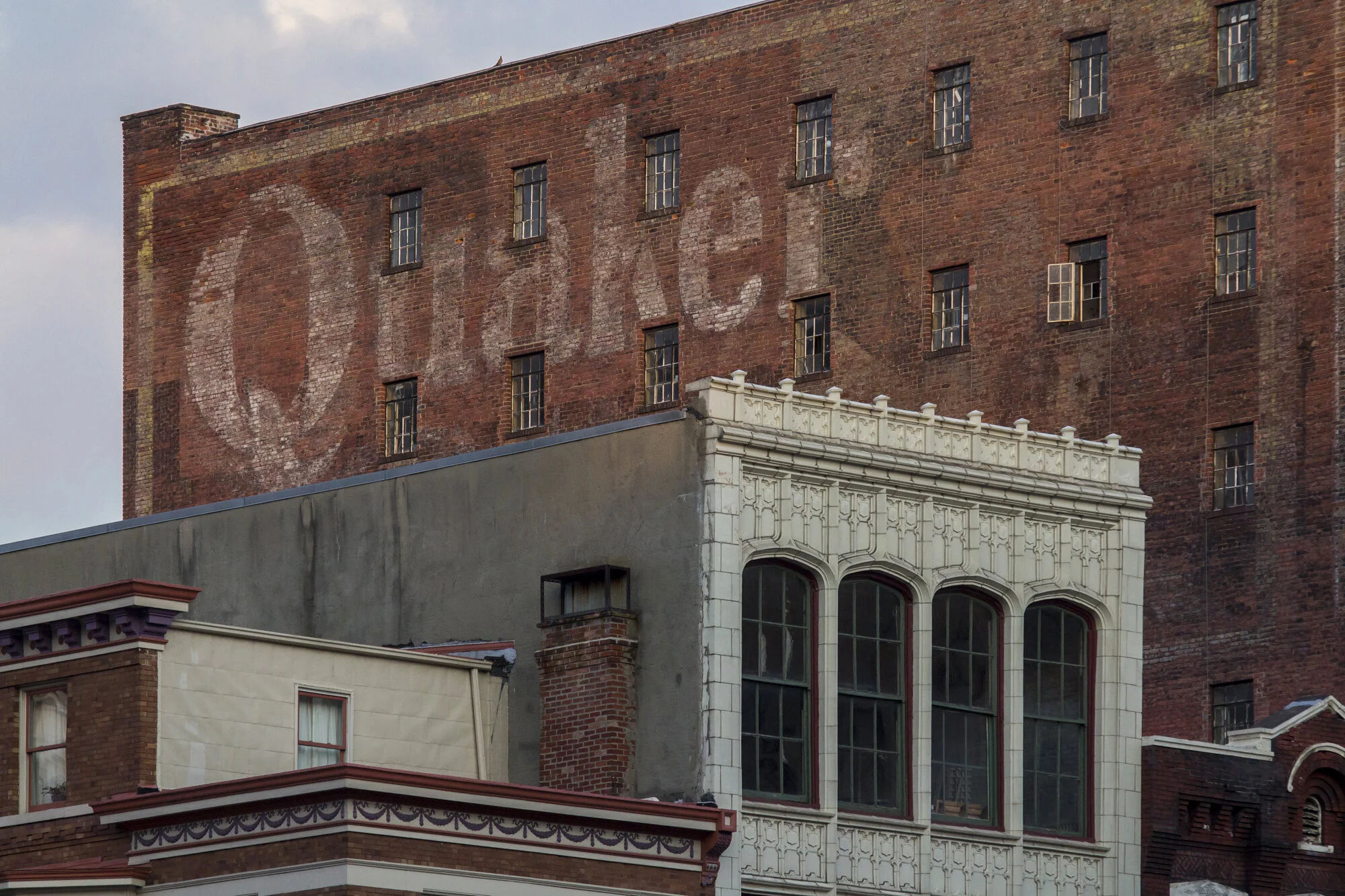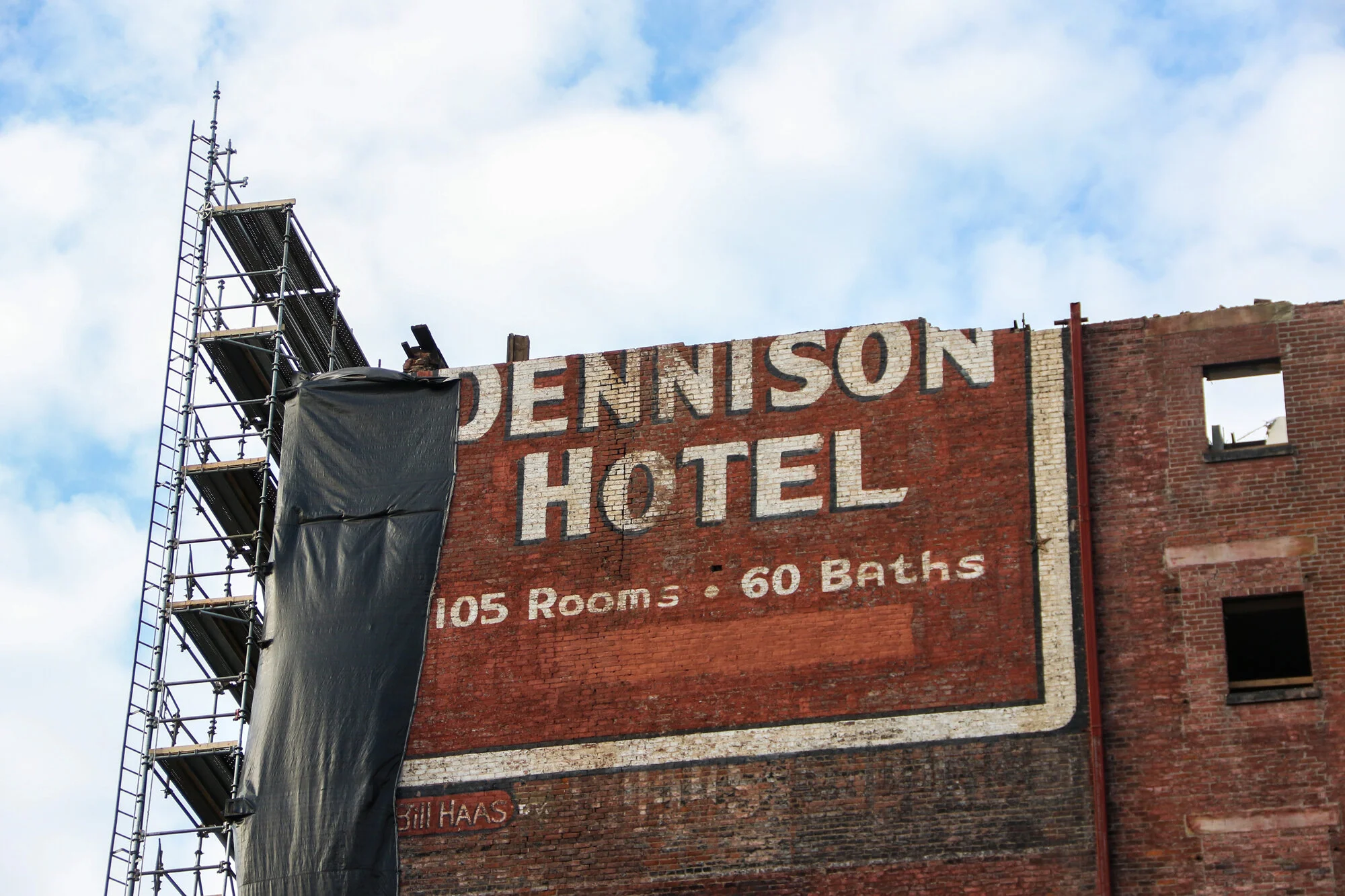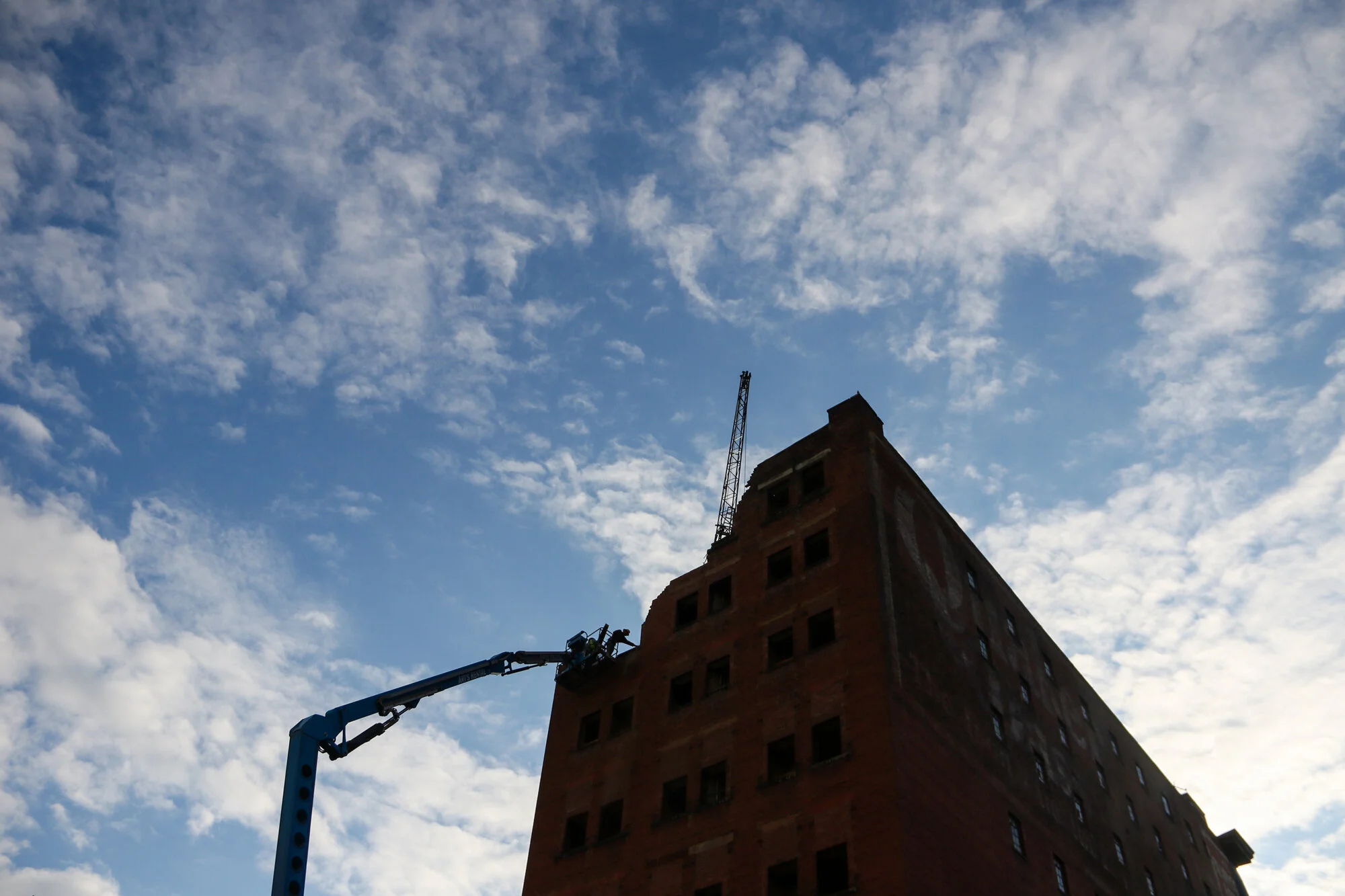Death of The Dennison
1892 - 2017
The Dennison Hotel building once stood on the eastern side of Downtown Cincinnati's Main St. between 7th and 8th Streets. The building was part of the "Cincinnati East Manufacturing and Warehouse District," an area officially catalogged with the National Register of Historic Places.
By The Hand of Hannaford
The building was one of 300+ structures designed by acclaimed American architect Samuel Hannaford. Based out of Cincinnati, some of Hannaford's most iconic works included the city's Music Hall and City Hall, as well as, many other landmarks throughout the United State's 30th largest metropolitan statistical area.
Google Maps view (Fall 2019) of the former Dennison location. The entire block was once full of historic buildings, now mostly reduced to surface parking.
The Dennison as seen in April 2016.
Many neighboring buildings on the same block had been demolished for parking decades prior.
Sign(s) of the Times
The debate surrounding the future of the Dennison sparked a battle between the merits of preservation vs. demolition in a rapidly revitalizing and gentrifying urban core. Just a few blocks south of the nationally registered "Over-The-Rhine Historic District," the former hotel sat in a designated historic district of its own amongst a downtown that has historically demonstrated a mixed record of preservation.
Known as a flophouse in its waning years, the building was also recognizable from the handful of fading advertisements, or "ghost signs," that emblazoned its sides—historical markers signifying its past life. Hand painted billboards on the north and south facades read (to the amusement of many): "105 Rooms • 60 Baths." Another sign on the north end highlighted the building's prominent location, an ideal place to once advertise "Quaker Oats" to the public.
These fading advertisements were once local landmarks and were also prominently featured in the 2015 publication Fading Ads of Cincinnati.
Proposed Revival, Proposed Replacement
The Dennison was one of a handful of formerly prominent downtown lodging establishments that eventually came to be labeled as flophouses. According to Anne Senefeld of Digging Cincinnati History, $80-$110 could afford a renter one week in 1999 (~$122-$170 when adjusted for inflation in 2020). Across the street, the former Fort Washington Hotel was revived as high-end condos while another nearby example, The Metropole, had been reborn as the upscale 21C Museum Hotel. The Dennison hosted its last tenants in 2011.
Like its counterparts, plans were occasionally floated for a revival of the Dennison. A 2011 collaboration between multiple nonprofits and The Model Group (a local architecture and real estate firm specializing in historic preservation) sought to renovate the building into studio apartments and affordable housing. In 2013, the City of Cincinnati partnered Center City Development Corporation (3CDC) purchased the building and a month later sold it to Columbia Oldsmobile Company—a local business group run by the Joseph family that includes several automotive dealerships and real estate holdings amongst its portfolio. As reported by the Cincinnati Enquirer on January 14, 1987—Columbia had purchased and demolished several other buildings on the block in pursuit of a large scale development project decades prior. As of this writing, the parcels from 1987 are still surface parking lots.
As chronicled in reporting by Nick Swartsell of City Beat, Columbia REI, LLC and the Joseph family had initially purchased the building to counter the affordable housing plan, believing it could be detrimental to their future real estate aspirations on the same block. In 2016, Columbia filed a request to demolish the Dennison, stating that the building had deteriorated beyond function and that its removal was necessary for future plans on the site. A tarp went up over the building's detailed, ornate facade and fencing was erected to allegedly protect passersby from the "crumbling" structure. As a series of legal battles ensued over the building's future, Columbia floated renderings of a proposed building for most of the block—office space that could serve as the headquarters for a yet-to-be-lured Fortune 500 company.
Preservationists were quick to point out that the building was not just historically significant and had once been a strong candidate for rehabilitation, but that it also resided in a protected historic district. Those critical of the Columbia plans were quick to point out the Joseph family's ties to influential local figures. In an editorial for Soapbox, writer Casey Coston made note of the family's substantial financial contributions to Democratic Mayor John Cranley (totaling $41,900) who took strategic positions during the debate over the building's future. In addition to the family's political support, Coston also noted their automotive group's substantial advertising in the local paper of record, The Cincinnati Enquirer, where the editorial board wrote on April 21, 2016 that it was "time to let the Dennison go."
Rendering of the proposed 2011 affordable housing revival. Image via Soapbox Media.
A shirt designed by artist Phil Armstrong that was sold in support of saving the building.
Renderings released by Columbia REI, LLC showing the potential for new construction on the block.
History
The Dennison originally began life as the headquarters of the G.B. Schulte Sons Company which built iron parts for carriages. The company used the building as a manufacturing facility until 1930 when part of the structure became the "Main Hotel."
By 1933, the hotel was rebranded as the "new" Dennison Hotel, a relocation from down the road.
Advertising 105 rooms, but only 60 baths—The Dennison Hotel would've been atypical of the era, but by all accounts failed to adapt as time went on.
Eventually derided as a flophouse, the Dennison was known for cheap rent and a shoddy reputation. As a young photographer on the hunt to document abandoned buildings, there was always a question of whether or not the Dennison was deserted or active.
While the building was beautiful, it often appeared derelict until you'd see someone manning the front desk or the occasional tenant coming and going from the front entrance. In a relatively busy (and nine-to-five business heavy) corner of Downtown Cincinnati, the Dennison was somewhat of an enigma.
I never had an opportunity to photograph its interior.
In April 2016, I opined on Queen City Discovery that "Some Things Are Worth Saving." By this point, the legal battles between those who sought to demolish the Dennison and those who sought to preserve it was reaching a precipice. Those advocating destruction spoke of future potential while those opposing demolition pointed out that the powers behind the wrecking ball had been making the same unfulfilled promises for decades. There was also the issue that the Dennison resided in an "historic district." The Cincinnati I began photographing at the age of 16 in 2005 was quite different than the one I was seeing at the age of 27 in 2016. For example, the nearby and popular Over-The-Rhine neighborhood had experienced a renaissance bolstered by the fact that it had managed (in spite of development efforts) to keep a large portion of its historic building stock intact. The Dennison, a seemingly perfect candidate for rehabilitation, seemed like it was hardly an obstacle to progress. In a city that loves to market its history as an asset (such as having the first professional baseball team in a metropolis of beer loving, Oktoberfest singing Germans), it seemed counterproductive to demolish an historic structure designed by a local legend.
"Cincinnati has this feel to it and it's always apparent when one uses the Fountain Square parking garage below ground. You walk up the stairs and outside there's this rush of air, a hum of noise. It hits you, you're in the city. When you walk the downtown streets, the buildings tell a story. They're physical representations of the city's history—from historic structures to bland office towers to the skyscrapers of the late 20th and early 21st centuries. The most character comes from the older buildings, though—the ones that were planned with design and beauty in mind.
Aesthetic and message over cheap materials and pastel colors.
Quality that isn't often replicated today.
They all differ in appearance, but come together to form an urban fabric. The Dennison is an essential piece of that fabric. Even in its neglected state as rain pours from the sky, the details still protrude out and echo the artistry of Samuel Hannaford."
- Queen City Discovery, April 27, 2016
Since the Dennison resided in a nationally recognized historic district, the demolition required some civic approval. Columbia submitted their request to the city’s Historic Conservation Board, a group made up of political appointees. Per the reporting of the Cincinnati Business Courier’s Chris Wetterich in June 2016: “In a 3-2 vote, the board found that owner Columbia REI LLC did not demonstrate that the building could not be rehabilitated in an economically viable way.” The demolition request was denied, but Columbia was free to appeal to the city’s Zoning Board of Appeals.
By December of 2016, after two separate hearing sessions, the Zoning Board of Appeals (also the realm of political appointees) reversed the Historic Conservation Board’s decision by a similar 3-2 margin. Demolition of the building could now proceed as groups such as the Cincinnati Preservation Association and the Cincinnati Preservation Collective vowed to fight on. As noted by Wetterich’s further Courier reporting, though: any legal avenues likely couldn’t be navigated in time to halt the demolition. Throughout the process, Columbia and the Joseph family were represented by prominent, local political figures—attorney Tim Burke, who was the current Hamilton County Democratic Party chairman, and attorney C. Francis Barrett. Following the decision, Barrett was quoted in the Business Courier discussing the cross-examination of the city’s urban conservator Beth Johnson: “I think what happened here was she was put in a very unfortunate position. They (preservationists) become very upset. They go to city council if they don’t get their own way. Someone in the city administration needs to protect city employees.”
As the building’s final days were numbered, the Cincinnati Preservation Association would eventually release the following statement on their website:
"CPA and CPC [Cincinnati Preservation Collective] worked together to save the Dennison by supporting the city regulatory process and by bringing highly qualified developers to the owners [Columbia] for purchase or land lease of the property. The project was reviewed by many experienced developers. Their overwhelming opinion was that the building could have been successfully redeveloped as apartments. The parking lot site is already large enough to construct any development that might be possible. Preserving important historic buildings has been very good for Cincinnati. The Dennison can add to the revitalization that is underway."
- Cincinnati Preservation Association, January 13, 2017
Destruction of the Dennison began in early 2017. At the time, I happened to work just a block away. My regular bus stop stood in the shadow of the wrecking ball and on days when I'd be on my bike—I had to pedal right past the dust cloud of debris. I began photographing the building's downfall. The following photographs chronicle an historic structure's demise and culminate with what has replaced the space as of this publishing (May 21, 2020).
April 26, 2016
February 16, 2017
February 17, 2017
February 22, 2017
Several demonstrations occurred as the Dennison met its demise.
February 23, 2017
February 27, 2017
March 1, 2017
March 2, 2017
March 22, 2017
March 29, 2017
April 7, 2017
April 18, 2017
April 19, 2017
May 3, 2017
May 12, 2017
May 15, 2017
May 16, 2017
May 19, 2017
May 22, 2017
May 24, 2017
Jun 2, 2017
June 6, 2017
June 9, 2017
November 20, 2017
December 6, 2017
December 14, 2017
February 13, 2018
March 13, 2019
After demolition concluded in the Spring of 2018, speculation was rampant that the building's former footprint would be replaced with even more parking on the block. However, after a once adjoining building was affixed with vinyl siding, a "green space" emerged in place of the Dennison.
In contrast to traditional park space, though, the grass is synthetic and the area is closed off to the public via a padlocked fence.
April 2, 2019
May 20, 2020
As of this writing, the former location of the Dennison is still occupied by greenery, mulch, and an astro-turf surface akin to a miniature golf course.
The rest of the block is still occupied by surface parking, just as it has been since the late 80s. In the background of this photograph is the Power Building (left), a former commercial building renovated into a luxury apartment complex known as "The Renaissance" in 2002. It is included in the same protected historic district that the Dennison once was. "Encore Urban Living" (right) opened in 2017 and replaced a parking garage in addition to a two-story office building.
The final four remaining buildings on the block date back to (from L to R) 1905, 1916, 1884, and 1884.
Epilogue
I wanted to share these images so that they might serve as an historic record. The City of Cincinnati and the surrounding region actively market history as a commodity, something to be proud of and shared—an appealing reason to live and work here, whether you come from far or near. As I've documented since 2007 via the former Queen City Discovery, the local history is filled with mixed examples of preservation and historical consideration alongside missteps and head-scratching decisions. This is a city that preserved its incredible Art-Deco train station and allowed for the birth of modern, architecturally significant structures, but it's also the place left a subway transit system half-finished and is still debating the future of other significant buildings.
The Dennison, for all intents and purposes, may not have been the most significant building to grace the Queen City's streets, but it spoke to larger issues such as new development being mostly centered around luxury with little regard for affordability. Who, is the Cincinnati of the future for? Will the quickly built downtown condominiums and office space of today age as gracefully as a solid structure such as the Dennison?
Ultimately, the building's story raised a question that has plagued the area for decades—one that exists not just in relation to architecture, but to transportation, poverty, housing, development, and many other facets of life:
In a city supposedly so proud of its history, so quick to shout it from the rooftops—is Cincinnati actually learning from that history?





































































































